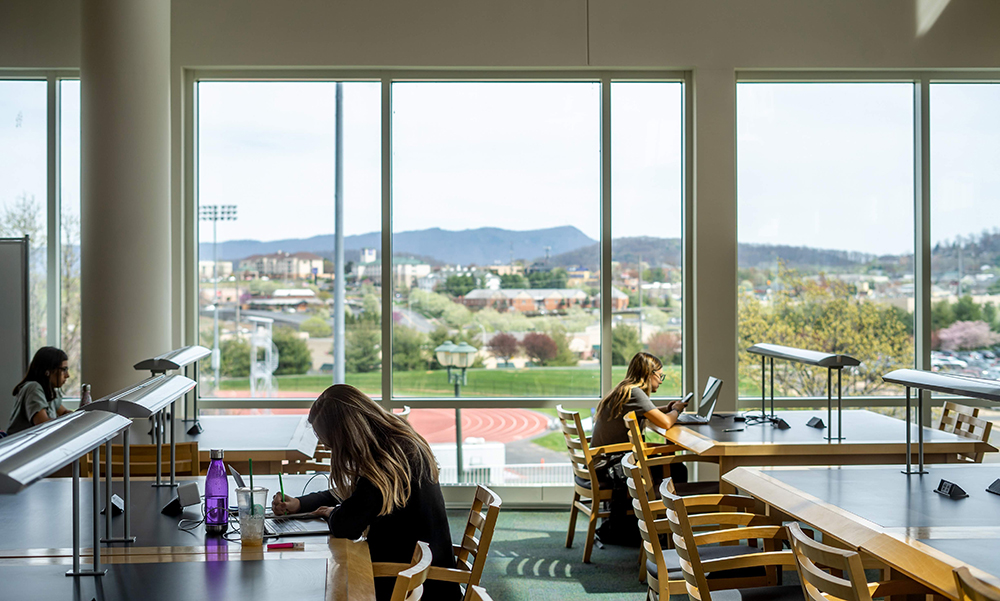Institute for Online Learning: Fall 2020
Faculty ready for students in hybrid and online classes
News
SUMMARY: JMU Libraries has been preparing professors to teach online for about 20 years, but this year is radically different. Dean of Libraries Bethany Nowviskie emphasizes how the university was perfectly positioned to adapt to the increase in demand for online educational support.
JMU Libraries has been preparing professors to teach online for about 20 years, although not on the current scale. In the past, a comparatively small number of faculty members needed to design courses for online instruction each year, and since 2008 the libraries have offered a 30-hour, semester-long professional development course for 12 to 15 participants in the spring. Enrollment was capped because the training was based on in-person meetings and consultation.
But this year is radically different. Other colleges and universities are looking to JMU to see how library professionals managed to scale up dramatically what used to be such a small program into one that has the capacity to serve all 1,000-plus faculty members.
Dean of Libraries Bethany Nowviskie emphasized how the university was perfectly positioned to adapt. In conversation with peers across the commonwealth and the country, she learned that few other places have this combination of experts and know-how in exactly the right place at this crucial time: The core technology infrastructure for education, instructional design and librarianship are all housed together in the JMU Libraries.
“So we wound up, through the pandemic, in much deeper partnerships and having problem-solving conversations in a way that my colleagues at other institutions were not,” Nowviskie said. She applauds the university for its foresight in the last two decades, upgrading needed educational technology and hiring specialists, among them Juhong Christie Liu, an associate professor in the libraries and senior instructional designer/head of online learning.
Faculty requests for assistance inspired the new Online Learning Institute, according to Liu. “We started this self-paced summer institute, a five-module online course for the faculty to gain the flexibility and get the needed foundation and knowledge for teaching in an online environment,” she said.
Liu, who is nationally known in her field, noted the difference between what happened in the spring—suddenly switching to web-based delivery of all instruction—and designing courses with best practices and principles for online learning baked into the curricula. Getting comfortable with presentation tools like Techsmith Knowmia and the new equipment, particularly special cameras and microphones that have been installed in campus classrooms, is part of it. But the gear doesn’t guarantee a good outcome.
Good teaching—pedagogical excellence—still trumps tech. In the institute, professors translate their in-person teaching skills according to the unique conditions of learning online and in alignment with learning objectives. They also gain personal experience of being educated this way, which is a blend of asynchronous course work with synchronous consultations, presentations and redevelopment of courses.
“I've learned what I need to do, how to do it and why,” communication studies instructor Julie Gochenour said. “So I can provide my students with a quality online learning experience that’s consistent with JMU’s reputation for student-centered instruction.
“I truly had no idea how to optimize online learning when we transitioned from face-to-face classes to distance learning after spring break. While there are some similarities between online and classroom instruction, there are also significant differences that we must navigate and manage for students to successfully learn in the digital experience.”
Gochenour is one of more than 300 professors who have enrolled in the institute so far. She credits its evidence-based approach and emphasis on practical skills with making worthwhile the “surprising amount of time and effort—more than students and parents could ever imagine” she has invested in getting ready for fall.
Liu and Jess Lantz, assistant professor and instructional designer, conduct the Online Learning Institute with collaboration and input from the Center for Faculty Innovation, JMU librarians, educational technologists and other campus partners. Liu and Lantz provide collegial support with office hours and feedback on key modules, and participants teach one another, too. Peer-to-peer learning is a central feature of the institute, as is the instructional community that is available upon completion of all five modules.
Enrollment continues to grow as more people recognize the importance of contemplating, planning for and conducting classes online—and ensuring a student experience at least equal in quality and learning outcomes to an in-person class. Registration for the institute opened on April 20 and will close Aug. 21, five days before JMU classes begin. Plans for additional training resources continue to evolve.
Faculty Resources
- Enroll in our self-paced Institute for Online & Hybrid Learning
- Ask the Library questions about Canvas, library resources or teaching online.
- Classroom Technology information is updated as available.
- Course Reserves management system is fully online now for Carrier Library, Rose Library and the Music Library.
- Equipment loans are available for faculty and staff.
- Guide to Hybrid & Online Teaching is new!
- Request a personalized consultation with JMU Libraries’ experts.
